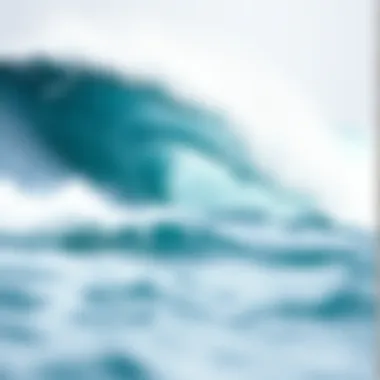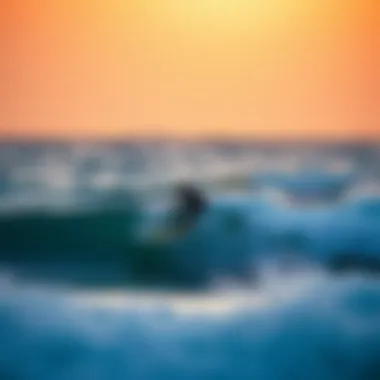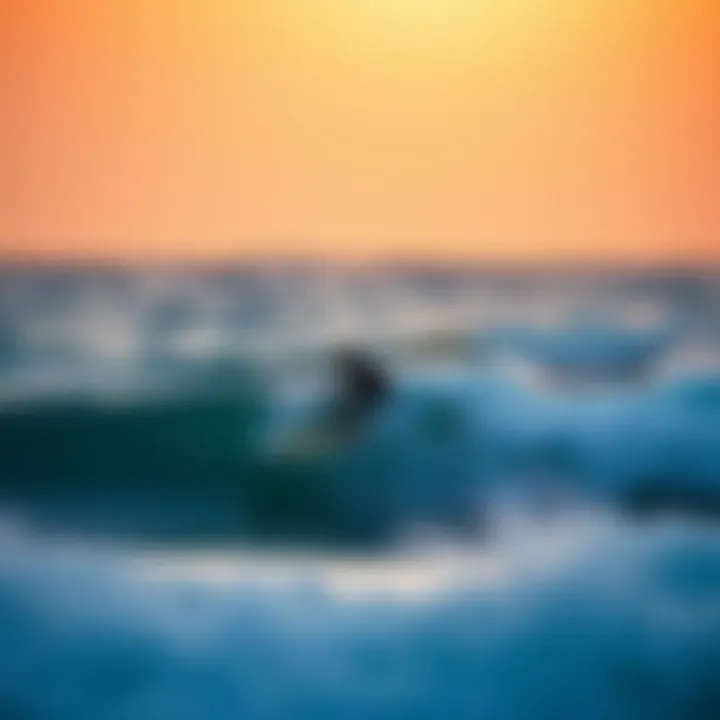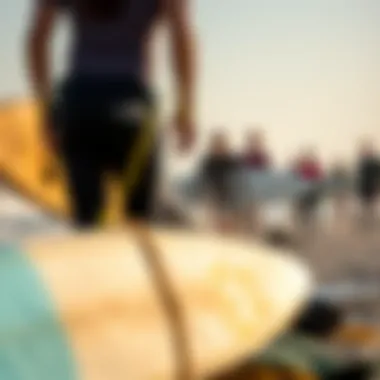Exploring Ocean Surfing Culture: History and Impact


Intro
Surfing isn’t just a sport; it’s a way of life intricately woven into the fabric of coastal communities worldwide. Picture the sound of waves crashing against the shore, the smell of salt in the air, and the thrill of navigating the ocean's swells. Each of these elements brings together a rich tapestry of traditions, practices, and shared values among surfers. This article takes you on a journey through this vibrant culture, highlighting its various dimensions—the techniques that define the sport, the lifestyles of those who live for it, and the environmental considerations that must be embraced in today's world.
As we explore the facets of surfing, you'll discover how fundamental techniques can shape one's experience, and how a deeper understanding of suring practices can lead to better riding. We will venture into the vibrant lifestyle that surrounds the surf scene, showcasing sustainable practices that preserve the ocean’s beauty. In doing this, we hope to connect with everyone from seasoned surfers to curious newcomers, providing insights that resonate across generations.
Now, let’s dive into the technical skills that make a surfer truly at home in the water.
The Essence of Surfing
Surfing isn’t just a hobby; for many, it’s a way of life. This cultural phenomenon, rooted in passion and adventure, has woven itself into the fabric of numerous societies, creating a rich tapestry that extends beyond the act of riding waves. In this section, we will explore the essence of surfing, emphasizing its historical foundations and deep connection to nature. By understanding these aspects, we can appreciate how this sport fosters a community of like-minded individuals who share a profound love for the ocean and its mysteries.
Historical Foundations
Origins in Polynesia
Ever since the waves began rolling, surfing has been an integral part of Polynesian culture. The roots of surfing can be traced back to ancient times when the indigenous people first crafted their wooden boards. This primitive yet captivating form of transportation across the waves laid the groundwork for what we now know as surfing. Polynesian chiefs were often seen riding in front of their communities, showcasing their skill and bravery. This not only raised social status but also created a deep-rooted connection between individuals and their environment.
One fascinating thing about the origins in Polynesia is the communal essence that it brought forth. Surfing was not just a solitary activity; it created bonds between people, strengthening ties within the community. The beauty of this historical foundation lies in its ability to unite individuals, forming lifelong friendships forged in the embrace of the ocean.
"Surfing is not just a sport; it's an experience that connects us to our roots and to each other."
Evolution Through Time
As we moved through the ages, surfing transitioned from a sacred practice to a more inclusive and global phenomenon. Its evolution has been marked by technological advancements and shifts in cultural perceptions. From the simple wooden boards of Polynesia to the contemporary longboards and shortboards made of high-performance materials, surfing has adapted and flourished.
This evolution reflects the changing desires of surfers. Where once it was a mere leisure activity for a select few, surfing has now become a competitive sport, attracting athletes from all corners of the globe. This change opened new doors and brought fresh perspectives, allowing people to experience the thrill of catching a wave regardless of their background.
However, while this evolution has broadened access to surfing, it often tends to overshadow the rich traditions that anchored its inception. It’s vital to retain elements of its origins, instilling respect for the culture and maintaining the spirit of community.
Influence of Cultural Practices
The influence of various cultural practices on surfing cannot be overstated. Different regions around the world have imparted their unique touches to the sport, creating variations that reflect local customs, traditions, and lifestyles. In California, surfers adopted a laid-back lifestyle characterized by beach parties and live music, while in Hawaii, the sport is steeped in ritualistic significance, respecting the spirit of the ocean.
The blending of cultures has led to the birth of surf styles and techniques that differ regionally. Each location contributes its flavor to the surfing experience, resulting in a rich mosaic of practices that embody the heart and soul of what surfing means to its enthusiasts. This cultural diversity is essential for preserving the art and essence of surfing for future generations.
A Connection to Nature
The Ocean as a Playground
For surfers, the ocean is not merely a body of water; it's an expansive playground where freedom, exhilaration, and serenity converge. The thrill of riding a wave offers an unrivaled sense of joy. When one is out there, gliding on the surface of the sea, it's easy to forget the worries of daily life and connect with the elemental force that drives the tides.
Surfing nurtures a relationship with nature that few other activities parallel. Surfers quickly develop an understanding of their environment—recognizing different types of waves, weather patterns, and oceanic behaviors. This relationship promotes a lifestyle centered around respect for the environment and boosts an appreciation for the natural world.
Understanding Tides and Waves
To be a successful surfer, it is crucial to grasp the nuances of tides and waves. The interplay of these elements dictates where and when one should surf, making knowledge of ocean dynamics essential for anyone who wants to ride its swells effectively. Each wave carries its own story, shaped by conditions at sea that vary by region, season, and time of day.
Surfers often spend hours observing the water, learning about the subtle signs that indicate a great surfing day versus a less favorable one. This kind of mindfulness and observation aligns surfers closer to their environment, encouraging a deeper connection with the ocean and its ever-changing moods.
Respecting Marine Life
Respecting marine life is paramount for surfers and the surfing culture at large. The ocean is home to a myriad of creatures, each playing an essential role in the ecosystem. With the growing awareness of environmental issues, surfers have taken it upon themselves to advocate for the health of the waters they love.
Emphasizing sustainability in surfing, many are joining grassroots movements aimed at protecting marine habitats and advocating against pollution. This commitment mirrors the surfing community's values, which emphasize harmony with nature. Together, surfers hope to ensure that their playground remains vibrant and healthy for generations to come.
The Art of Surfing Techniques
Surfing isn’t merely about riding waves; it's a complex dance with nature that demands a depth of knowledge and an array of techniques. The art of surfing techniques encompasses the foundational skills required to successfully navigate the ocean, effectively perform maneuvers on a board, and fully appreciate the sport. Mastering these techniques elevates the practice from a mere pastime to an expressive form of artistry. Surfers who hone their skills experience increased control and connection with the waves, leading to a more enriching and exhilarating experience.
Fundamentals of Paddling
Effective paddling serves as the backbone of surfing. Before a surfer can catch that spectacular wave, mastering paddling is essential. It’s all about harnessing body mechanics to glide through the water efficiently.
Posture and Technique
The posture maintained while paddling significantly influences performance. A proper stance, with the chest raised and core engaged, allows for better utilization of arm movement and body balance. Maintaining a straight back curvature optimizes drag and speeds up the process of getting to the desired position.
Also, it's advisable to keep the elbows slightly bent rather than locked out, as this fosters a more fluid movement through the water. This technique isn’t just a popular choice among seasoned surfers but a necessity for efficient movement. However, if one neglects posture, it could lead to fatigue or inefficient paddling, making it challenging to catch waves.
Paddling Strategies


Paddling strategies involve understanding how to maneuver efficiently in various conditions. This means knowing when to paddle hard to gain momentum, versus when to conserve energy. A common strategy entails performing short, strong strokes to quickly enter the lineup, especially in crowded surf spots.
One notable feature is the "the catch," where the hand enters the water and pulls backward in a streamlined motion. This technique is particularly favored as it maximizes energy transfer, allowing for a quicker response to incoming waves. Failing to have a solid strategy can lead to missed opportunities to catch waves or premature exhaustion.
Timing and Positioning
In surfing, timing and positioning are crucial, determining whether a surfer is in the right spot to catch a wave. Understanding the mechanics of wave formation is key. Surfers who position themselves carefully can anticipate when to paddle and catch a wave effectively.
A key technique is watching the wave's swell to gauge timing. When done correctly, surfers can feel the energy of the wave lift them up before they even start paddling. Being out of sync, however, can mean missing the perfect ride or, worse yet, falling off balance at the worst possible moment, thus emphasizing its importance.
Mastering the Wave Ride
Once you’ve paddled into position, the next stage is about transforming potential energy into dynamic movement on the water. Making the wave ride an unforgettable experience helps surfers deepen their relationship with the ocean.
Initiating the Take-Off
The take-off is crucial. Timing is, again, of utmost importance. Surfers must learn to recognize the telltale signs that indicate when a wave is about to break. The direct approach involves pushing against the board and using the arms for additional leverage.
Surfers experience an adrenaline rush at this moment. A well-timed take-off not only maximizes speed but also sets the stage for a smooth ride. If the take-off is mistimed, however, it can lead to wipeouts or missed opportunities to gain momentum.
Turning and Trimming
Turning and trimming become essential once on the wave. It involves shifting weight and carving through the water as a way to maintain speed. A key point is the concept of "rail control," which indicates how well a surfer uses the side of their board to steer. Surfers who excel in these techniques manage to adapt to changes in wave conditions, shifting their weight to stay balanced atop a moving surface.
Getting adept at these moves pleases the audience watching, improving both style and technical skills. A common pitfall is over-commitment to aggressive turns, which may lead to loss of balance.
Advanced Maneuvers
For those looking to truly stand out in the surf culture, mastering advanced maneuvers is essential. This includes techniques like aerials or radical snaps, where surfers push the limits of skill while catching air off the lip of a wave.
Surfers often strive for unique maneuvers that reflect their personal style. The sheer creativity and individuality expressed in these moves make them thrilling not only to perform but also to behold. The downside? These maneuvers require immense skill and can lead to falls, leaving surfers vulnerable to ocean currents. Evaluating risks versus rewards becomes necessary at this level of expertise.
Mastery of surfing techniques transforms the experience from a mere act of riding waves to an art form. Those who invest time and effort reap greater rewards in both skill and satisfaction.
Essential Equipment
Having the right gear is critical to mastering surfing. Equipment not only enhances performance but ensures safety and comfort while navigating the waves. Whether someone is a seasoned surfer or just starting out, understanding the equipment is key. This section dives into two major categories: surfboards and safety gear. Each facet contributes to the overall surfing experience, emphasizing the vital role of appropriate equipment.
Surfboards: Varieties and Selection
Different Board Types
When it comes to surfing, one size does not fit all. There are several types of surfboards, each tailored to different styles and waves. The most common types include shortboards, longboards, fish boards, and funboards. Each board has its unique characteristics that cater to various skill sets and preferences.
- Shortboards are widely acknowledged for their maneuverability, thanks to their compact shape. These are the go-to for advanced surfers looking for speed and performance.
- Longboards, on the other hand, offer stability and are excellent for beginners. Their length allows them to glide smoothly over waves, making them a popular choice for leisurely surfing.
- Fish boards are a hybrid style, known for their wide bodies and short length. They excel in smaller waves and are perfect for those who love a playful ride.
For those keen on catching waves, choosing the right board can significantly improve paddle performance and ride capability. However, it's crucial to remember that a board tailored to personal style might not always suit someone else's needs, making it essential to experiment to find the perfect fit.
Selecting the Right Size
Size matters—a lot. When selecting a surfboard, the length, width, and thickness are key factors that determine how a board performs. Beginners might often opt for larger boards, which provide stability, while experienced surfers might lean toward shorter boards for agility.
- Length typically corresponds with a surfer's height and weight. A general rule of thumb is to choose a board around 2 to 6 inches taller than the surfer.
- Width affects how easily one can paddle and balance on the board. A wider board offers more surface area but can be cumbersome in tight turns.
- Thickness influences buoyancy and weight capacity, making it a defining feature for performance.
Choosing the right size is not just about comfort. It's about enhancing the overall surfing experience. A wrong size might lead to frustration, while the right one can open up possibilities in the surf.
Materials and Designs
Today’s surfboards come from various materials and innovations. The material influences performance, durability, and even eco-friendliness. Common choices include polyurethane, epoxy, and more recently, eco-conscious alternatives like bio-resins.
- Polyurethane boards are known for their classic feel. They offer good performance but are generally less durable over time.
- Epoxy boards weigh less and are more resistant to damage, thanks to their solid construction.
- Eco-friendly boards made from sustainable materials reflect a growing awareness within the community about environmental impact.
Each of these materials has its pros and cons, with some leaning towards performance while others focus on sustainability. Opting for the right material can impact surfing experience on multiple fronts, confirming the importance of being informed.
Safety Gear and Accessories
Wetsuits and Their Importance
In cold waters, a wetsuit is more than just an accessory—it's a necessity. Wetsuits provide insulation and protect surfers from hypothermia. They come in various thicknesses, enabling customization based on water temperatures.
- Thicker wetsuits are ideal for frigid waters while thinner options cater to warmer climates, offering flexibility and protection.
- Materials used in wetsuits, such as neoprene, vary widely in quality, impacting comfort.


Having a good wetsuit can prolong sessions in the water, allowing surfers to focus on the waves rather than shivering from the chill.
Leashes and Fins
Two elements that often get overlooked are leashes and fins, yet they play an essential role in safety and surfboard performance.
- Leashes keep surfers attached to their boards, reducing the risk of losing the board, which can become a hazard for both the surfer and others in the water.
- Fins alter how a surfboard handles the waves. Different fin setups can impact speed, grip, and maneuverability, making it critical to select the right combination.
These accessories, though simple, contribute significantly to the overall surfing experience, ensuring it remains enjoyable and safe.
Surfboard Wax and Maintenance
Another important aspect is the maintenance of surfing equipment, primarily through the use of surfboard wax. Wax enhances grip, allowing surfers to stay attached to their boards during rides.
- Different types of wax cater to varying water temperatures. Applying the appropriate wax ensures optimal performance.
- Regular maintenance and checks ensure equipment longevity, avoiding the need for frequent replacements, which can be both financially and environmentally burdensome.
Surfing Communities and Culture
Surfing isn't just a sport; it embodies a lifestyle woven into vibrant communities worldwide. This section underscores the crucial role that surfing communities play in fostering a culture rooted in shared experiences, mutual respect, and an unwavering bond with the ocean. For surfers, these communities provide not just camaraderie but also a platform for advocacy, especially concerning environmental issues.
Global Surfing Spots
Iconic Locations
When one thinks of surfing, the mind often wanders to iconic beaches like Waikiki in Hawaii or Banzai Pipeline on Oahu's North Shore. These spots don't just serve up world-class waves; they hold a significant place in surfing lore. Their well-known character makes them a magnet for surfers looking to carve their names into history.
Such locations offer varied wave conditions that cater to different skill levels, increasing their popularity. For instance, the gentle waves at Waikiki are ideal for beginners, while the treacherous barrels at Pipeline challenge even the most seasoned pros. Iconic locations are often equipped with necessary amenities such as surf schools and equipment rentals, which help newcomers dive into the sport without a hitch. However, the overcrowding during peak seasons can sometimes detract from the surfing experience, leading to competition for waves and beach space.
Emerging Destinations
On the other end of the spectrum are emerging destinations like Taghazout in Morocco or Tofino in Canada. These spots are increasingly gaining traction among thrill-seekers looking for new challenges. Emerging locations often offer uncrowded waves and less commercialization, giving surfers the chance to forge their own paths.
What sets these places apart is their raw natural beauty and cultural richness. Surfing in Taghazout, for example, isn't just about riding waves; it's about immersing oneself in a communal setting that showcases Moroccan hospitality. While they may lack some amenities of their more established counterparts, the allure of discovering hidden gems, interacting with local surfers, and embracing the authentic culture makes these locations particularly appealing.
Surf Festivals and Events
Surf festivals and events like the Maui Surf Festival or U.S. Open of Surfing act as pivotal gathering points for surfers worldwide. They create a festive atmosphere filled with friendly competition, music, and a celebration of surf culture. These events are instrumental in promoting awareness of the surfing lifestyle and introducing newcomers to the sport.
These festivals often highlight local talents and provide opportunities for tourists to observe or participate in surfing classes. However, one drawback is that festival-centric activities can detract from the primary essence of surfing as a personal journey. Yet, they serve to unite surfers from diverse backgrounds, fostering a spirit of camaraderie and shared passion.
The Bond Among Surfers
Shared Experiences
What truly fortifies the surfing culture is the shared experiences among surfers. From the anticipation of waiting for the right wave to the thrill of riding it, these moments create lifelong memories. They bind surfers together in kinship, forming connections that can transcend borders and backgrounds. This common language of waves and wipeouts brings surfers together at sprawling beaches and makes each encounter an opportunity for storytelling.
Unique experiences, like a first successful ride or a competitive victory, solidify friendships. On the flip side, the moments of wipeouts can also become the most talked-about anecdotes, showcasing the resilience and humor inherent in surf culture. This shared experience enriches the surfing community by creating a deeper understanding and appreciation among its members.
Local Surfer Communities
The local surfer communities form the backbone of this culture, offering support, mentorship, and a sense of belonging. Each community often has its distinct vibe shaped by local customs, styles, and surf conditions. Places like Malibu boast long-standing traditions and seasoned locals, while other areas may have newer enthusiasts adding fresh energy.
These communities often benefit from being tight-knit; they encourage newcomers to learn the ropes while respecting the ocean and beach etiquette. However, inclusivity can sometimes be a balancing act, as established surfers may initially be protective of their waves. Yet, the thriving exchange of skills and stories generally leads to camaraderie and growth for everyone involved.
Collective Environmental Efforts
As surfing communities become increasingly aware of environmental challenges, collective environmental efforts have taken root. Surfers unite to advocate for the preservation of marine ecosystems through clean-up events and partnerships with organizations like Surfrider Foundation. These activities not only demonstrate a commitment to the ocean but also positively impact local habitats by addressing litter and pollution.
The benefits of these initiatives are twofold: they protect the environments surfers depend on while also fostering a greater sense of community purpose. Many surfers feel a deep responsibility to safeguard the waves they cherish, tying their love for surfing to activism. On the downside, gaining widespread engagement can be challenging, especially when balancing surf culture with the urgency of climate issues. Still, the collaborative spirit showcases how passionately surfers rally around causes threatening their beloved ocean.
Environmental Considerations
Navigating the world of surfing is not simply about catching waves and enjoying the thrill—it's also an exercise in understanding how our beloved ocean and environment interact with our passion. The repercussions of human activity on the surf industry deserve attention. After all, surfers are often considered stewards of the sea, hence it's vital to reflect on how surfing aligns with environmental conservation. This section will explore pressing issues within the surf industry, ranging from pollution to sustainable practices, while emphasizing the significance of conservation efforts in safeguarding the oceans we cherish.
Impact of the Surf Industry
Pollution and Its Effects
Pollution is a scourge on various environments, but it profoundly impacts marine ecosystems and the quality of life for surfers. Contaminants like plastic waste, runoff from urban areas, and oil spills can harm marine life and pollute our surfing waters. These pollutants can affect not just the experience of surfing, but also public health and local economies dependent on tourism. The beaches we frequent might seem pristine, yet beneath the surface, the challenges posed by pollution can poison aquatic habitats and disrupt delicate ecosystems. A key characteristic of this issue is its unequivocal connection to the larger discussion about meeting the needs of modern society while preserving marine environments for future generations. With the rise of awareness, the push towards cleaner beaches and oceans gains momentum, making it increasingly crucial for surfers to remain informed and proactive in combating pollution.
Sustainable Practices


In response to pollution, sustainable practices within the surf industry are gaining traction. Companies are increasingly focused on reducing their ecological footprint. Initiatives like using eco-friendly materials for surfboards and accessories are becoming popular. This trend is a beneficial choice for the community as it shows commitment not only to the love of surfing but also to a broader environmental responsibility. The unique characteristic of sustainable practices lies in their dual function: they not only cater to surfers seeking performance and style, but also support the very ecosystems that provide those waves we chase. However, while some initiatives are making strides, many remain underdeveloped, and the challenge persists to educate consumers about the impact of their purchasing decisions.
Corporate Responsibility
With great power comes great responsibility, and the surf industry is no exception. As corporations wield significant influence, their obligations towards environmental stewardship intensify. Corporate responsibility manifests in various forms, such as initiating beach clean-up programs, enforcing stringent waste management policies, or investing in eco-innovations. This focus fortifies the industry's image and emphasizes its vital role in the overall narrative of surfing culture. The unique feature of corporate responsibility is its ability to align profit motives with ecological ethics, driving fundamental changes through the adoption of more sustainable business practices. However, transparency remains an issue, as many companies are only superficially engaged in meaningful environmental efforts.
Conservation Efforts
Grassroots Movements
Grassroots movements are pivotal in the fight for ocean preservation. Often emerging from local surfers and ocean advocates, these initiatives can ignite significant change at the community level and grow into more extensive campaigns. They represent a powerful collective voice, rallying surfers around common goals like fighting against pollution or advocating for marine protected areas. They are a beneficial choice for this discussion as they emphasize the importance of local action in a global context, empowering individuals to effectuate change. While grassroots efforts succeed in rallying support and raising awareness, their effectiveness can be hampered by limited resources and the need for wider systemic support.
Partnerships with Marine Organizations
Collaboration with marine organizations exemplifies how surfers can broaden their impact on conservation. By teaming up with NGOs or marine conservation groups, surf communities can leverage expert knowledge and resources. Such partnerships often lead to impactful conservation projects, be it the restoration of coral reefs or clean-up operations. This collaboration adds credibility and strategic support to conservation efforts, strengthening community engagement. While partnering with established organizations offers unique advantages, it can sometimes lead to a loss of local perspectives in larger initiatives, raising questions about balancing broader goals with local traditions.
Activism Within the Surf Community
Surf culture has birthed a spirit of activism among surfers who believe that riding the waves comes with responsibilities. Activism strengthens the community, as individuals and groups promote various environmental causes. Beach clean-ups, petitions against harmful policies, and campaigns for sustainable practices are testament to surf culture's potential for advocacy. This key characteristic is its inclusivity, as every pull of the tide can represent a wave of change driven by voices within communities. However, burnout and resistance can occur, as activists may face hurdles that seem insurmountable. Balancing a passion for the sport with the challenges of activism requires support and resilience.
In summary, environmental considerations are deeply intertwined with the essence of surfing culture. Each ripple in the ocean serves as a reminder of our duty to respect, nurture, and protect the natural world, ensuring that future generations can ride the same waves.
Lifestyle and Beyond
The culture of surfing is not just about the waves; it encompasses a broad lifestyle that reflects values, traditions, and an understanding of the world that goes beyond the ocean. Engaging with this lifestyle offers surfers and enthusiasts alike a chance to harmonize their daily routines with nature’s rhythm, enhancing both physical and mental well-being. This section explores various aspects of how surfing integrates into everyday life, the cultural expressions it inspires, and the broader implications on personal growth and community bonding.
The Surfing Way of Life
Integrating Surfing into Daily Routines
Many surfers find themselves seeking at least a slice of wave time every day, if not more. Integrating surfing into daily routines is not just a matter of scheduling surf sessions; it's about making a conscious effort to build a life around the ocean. Morning surfs often lead to a better outlook on the day ahead, and many maintain a focus on a healthy lifestyle to ensure they’re ready to catch each wave.
A distinctive quality of this integration is its ability to create balance in one’s life. Surfers often prioritize ocean time over other commitments, attributing the newfound balance to being in a natural setting. This can help alleviate stress and brings a sense of purpose to daily activities.
Yet, there are challenges. Not everyone has easy access to surf spots, and weather dependency can lead to frustration when conditions aren’t right. However, devising creative solutions, such as joining local surf clubs, can foster community interaction and make it easier to share surf time, thus enhancing one’s daily experience.
The Role of Surfing in Mental Health
Surfing has gained recognition for its significant impact on mental health. The act of paddling out and riding waves can serve as a form of therapy, allowing for a mental reset while being one with the ocean. The immersive experience offers a break from daily pressures, helping to calm the mind and boost mood.
An essential aspect of surfing’s contribution to mental well-being is the connection it fosters—not only with nature but also with fellow surfers. Being part of a community that understands the thrill and challenges of surfing creates an unparalleled support system.
However, it’s important to acknowledge that not all interactions in surfing are positive. The competitive nature can sometimes lead to pressure, especially among newer surfers aiming to keep up. This duality makes it crucial for individuals to find their comfort zone and enjoy the ride at their own pace without succumbing to external expectations.
Travel and Exploration
Surfing brings with it a spirit of adventure, making travel an integral element of the lifestyle. For surfers, every new location offers the promise of discovering unique waves and experiences. Traveling to new surf spots enriches life, broadening perspectives and allowing surfers to immerse themselves in diverse cultures.
One of the compelling qualities of travel associated with surfing is the openness to meet different people who share a common passion. This can lead to lasting friendships that transcend geographical boundaries, uniting diverse cultures through the love of the ocean.
However, traveling as a surfer is not without its drawbacks. The need for gear, which can be bulky, often limits spontaneity. Additionally, not all surf destinations are pristine; some may struggle with pollution and overcrowding, which could impact the overall experience. Ultimately, being mindful of these factors can lead to a more enriching travel experience.
Cultural Expressions
Art and Surfing
Surfing and art have long been intertwined, as artists often capture the spirit of ocean sports in their works. Whether it’s through vibrant paintings, photography, or sculptures, surfing conveys a unique aesthetic that reflects the beauty of the ocean. This fusion doesn’t just celebrate surfing; it elevates it into a form of cultural expression.
The unique feature of this relationship is the way art can capture waves and the surfing lifestyle, turning fleeting moments into timeless pieces. This encourages appreciation for both surfing and art, and in turn, can raise awareness for ocean conservation through visual storytelling.
Yet, some argue that commercialization may dilute the authentic connection that art has with surfing culture. It’s imperative for artists and surfers alike to maintain that intrinsic link, ensuring that authenticity remains central to their works.
Surf Music Influences
A significant part of surf culture is its music—a genre that has evolved alongside surfing itself. From the classic surf rock of the Beach Boys to modern interpretations, surf music encapsulates the essence of the sport: vitality, freedom, and fun. This genre does much more than entertain; it creates an atmosphere that resonates with action and adventure.
One interesting feature of surf music is its ability to uplift, providing a perfect soundtrack to ocean escapades. Many surfers find themselves inspired and invigorated by these tunes while they ride.
However, there’s debate on whether contemporary music can truly capture the raw emotions associated with surf experience. As trends change, finding that authentic surf vibe can become more of a challenge. Maintaining a balance between traditional sounds and new music could ensure an enriching auditory experience.
Literature Reflecting Surfing Themes
Literature has also played an essential role in surf culture, with writers penning titles focusing on the primal joy and community aspects of surfing. Various novels and poems reflect surfing’s challenges and triumphs, often showcasing surfers’ emotional journeys as they navigate life on and off the waves.
The beauty of literature dedicated to surfing is its ability to articulate feelings that might otherwise go unspoken. These works can foster understanding of the sport’s nuances, drawing in both surfers and non-surfers alike.
On the flip side, some literature may romanticize surfing, failing to portray its demanding aspects. Striking a balance between romanticism and realism can make for a more substantial influence in shaping how surfing is perceived by the wider audience.
Throughout these discussions, it’s evident that surfing is not just about the physical act; it’s an immersive cultural experience that continues to evolve, impacting lives beyond the shore.















